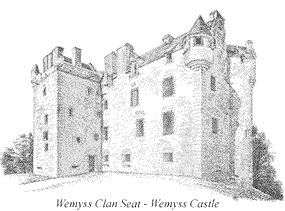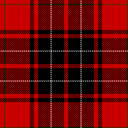
Clan Wemyss
(Wemyss is considered a sept of Clan MacDuff)
History
The name of Wemyss is derived from the Gaelic uaimh, meaning "cave", which in turn comes from the Pictish word, uahm, and is believed to be taken from the caves and cliffs of the Firth of Forth in that part of Fife where the family made its home. On the coast of Fife, below the ruin known as MacDuff's Castle are caves containing Pictish paintings and it is thought that these gave rise to local place name of Wemyss. (An interesting note: whenever the local clans/septs would get to feuding with each other in the coast of Fife, and a leader was captured, he was ritually drowned in one of the many pools located in the caves.)Wemyss has been the seat of the chiefs of the Clan Wemyss since the twelfth century and they almost certainly took their name from the land where they made their home.
The Wemyss family have the distinction of being one of the few lowland families directly descended from the Celtic nobility, through the MacDuff earls of Fife.
In 1290, Sir Michael Wemyss and his brother, Sir David, were sent with Scott of Balwearie to Norway to bring back the infant Queen Margaret, the "Maid of Norway". In 1296, Sir Michael swore fealty to Edward I of England, but he changed his allegiance to Robert the Bruce. Thereafter the name multiplied into many branches. The family seat, Wemyss Castle was built early in the thirteenth century and was sacked by the English after Sir Michael changed his allegiance to Robert the Bruce.
In 1315 Wemyss witnessed the Act of Settlement of the Scottish Crown by Robert the Bruce at Ayr. His son, Sir David, was one of those who appended his seal to the famous Declaration of Arbroath in 1320. Sir David appeared again, as one of the guarantors for the release from English imprisonment of David II, and his son was one of the hostages for his ransom, as his descendant, Duncan, was later to be for the liberation of James I.

The fourth Earl, born in 1699, was described as "a man of merit universal benevolence and hospitality the delight both of small and great". He married Janet, heiress of Colonel Francis Charteris of Amisfield. In the Jacobite rising of 1745, the fourth Earl’s eldest son, David, Lord Elcho, joined Prince Charles in Edinburgh. Appointed colonel of a troop of royal Horse Guards, he accompanied the prince into England, and was with him until his defeat at the Battle of Culloden. Elcho then escaped to France, and took part in the State entry of Prince Charles into Paris the following year. He was convicted of treason in his absence, and his estates were forfeited to the Crown. He continued to reside in France, and died childless in Paris in 1787. Consequent upon the attainder, the Jacobite earl was succeeded by his second son, Francis, who changed his name to Charteris, the family name of his maternal grandmother. It is from Francis that the present Earl of Wemyss and March, whose seat is the magnificent Adam mansion of Gosford, is descended.
The estates in Fife and the chiefship of the name of Wemyss devolved upon the Earl’s third son, the Honourable James Wemyss. He was MP for Sutherland, and married Lady Elizabeth Sutherland in 1757. His great-grandson married Millicent, the granddaughter of William IV, who, on the death of her husband in 1864, successfully took over the running of the estate for thirty years. Her son, Michael, married Lady Victoria Cavendish-Bentinck, the last surviving god-daughter of Queen Victoria. The present chief, David Wemyss of Wemyss who married Lady Jean Bruce, daughter of the Earl of Elgin, still has his principal seat at Wemyss Castle in Fife.
By the eighteenth century the Wemyss family were recognized as the senior representatives of the ancient earldom of Fife.

